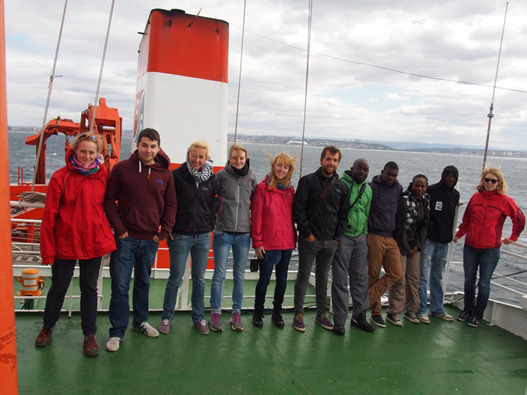Introduction
The SO234-2 research cruise will lead from Durban, South Africa to Port Louis, Mauritius. 9 scientists, 15 students, 1 observer and 25 crew members of the German research vessel SONNE set out from Durban on July 8th 2014 to investigate chemical and physical conditions of the West Indian Ocean and the atmosphere above it (result so far – windy and wavy!). The cruise, organized by GEOMAR, is part of the SPACES training program which aims at scientific exchange and capacity building between African and German students. These pair up and learn about oceanic and atmospheric measurements, in particular on air-sea gas exchange, under supervision of the scientists.
Setting up the instruments
Due to some delays, we could only start setting up the instruments in Durban harbor on July 6th instead of one day earlier as planned. Delicious food and lots of coke/coffee helped us to survive three days of unloading the containers, carrying boxes and setting up the labs. There were quite short nights for most of us, but now everything is set and running or waiting to be used.
Departure with Sonne
The weather prediction for the planned departure time (July 8th, 8:00 UTC, 10:00 local time Durban) was not ideal. High wind speeds and high waves were expected. But delaying the departure was finally due to some delayed dogs…
The morning of the departure came. Because of the expected high waves everything had to be double checked and lashed down safely. Thankfully the crew helped where they could while getting ready. Then the departure was postponed because the team with the dogs that were supposed to search the ship for stowaways hadn’t arrived yet. Everybody thus got a little extra time for preparation on a non-swaying vehicle.
After three (little) dogs had searched the ship thoroughly (no stowaways were discovered), we were ready to leave at 11:30. Unluckily this was also lunchtime and the food was devoured quickly in order to be able to watch the ship leaving the harbor from the monkey deck. Weather conditions included clouds and wind speeds of 5 Bf. After leaving the harbor the ship immediately started rolling and stomping.
Although, the ship doctor Dr. Heuser had distributed pills against seasickness, some students were affected by it and were not able to participate in the icebreaker on the first evening after departure. This had to take place on the “Kegelbahn”, since the main deck was closed due to the weather conditions. Still the first radiosonde was launched from the afterdeck under these conditions.
Most important issue for the first day: How to watch soccer on board? Luckily we were able to catch a TV signal and students, scientists and crew together were able to cheer for all seven German goals “one for all, all for one”.
In the next days we will head northeast, passing the Mozambique Channel and the coast of Madagascar and finally finishing in Mauritius. We hope to get some exciting results on CTD-casts, underway measurements of chemical active compounds and radio- and ozonesonde sounding. Cruising across the tropical West Indian Ocean we hope to fill this blank spot trace gas measurements on the research map!
Alina Fiehn and Gesa Eirund, SO234-2 students
